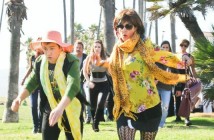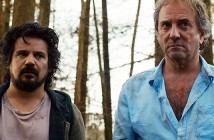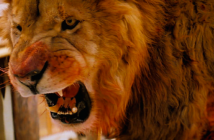Cast: Martin Freeman, Ian McKellen, Richard Armitage
Director: Peter Jackson
Country: USA | New Zealand
Genre: Adventure | Fantasy
Official Trailer: Here
Sixty years before the events of The Lord of the Rings, a respectable hobbit named Bilbo Baggins is abruptly visited by thirteen dwarves and the wizard Gandalf. His home, a gorgeously paneled and furnished hole on a hill, is thus suddenly overrun by foreigners, who talk of dragons, goblins, and all kinds of fabulous adventures. A brief prologue has already shown us how the dwarves lost their realm within the Lonely Mountain, how they were forced into exile when the great dragon Smaug ransacked their treasure hoard, and how now they dream of going back. In the Tolkien novel, there is no expository prologue. We learn the back-story only when Bilbo hears it from Thorin Oakenshield himself, grandson of the dead dwarven king Thrór. This adds mystery to the introduction of the dwarves, since we don’t yet know their plight when they first appear. Jackson is more impatient and explains everything in the opening minutes, which, however, serves to cut and streamline expository dialogue later on.
Peter Jackson, with each film he directs, perfects his technique for coordinating CGI with tangible, real-life actors, costumes, and sets.
At any rate, Bilbo, in both book and film, is torn by the competing calls of his maternal and paternal ancestries. Whereas the Baggins side of his family is conservative and provincial, his mother, Belladonna Took, comes from an adventurous lineage, prone to long expeditions and displays of bravery. Gandalf and the dwarves, during their raucous impromptu dinner, hire Bilbo as a burglar and fellow journeyman, but he turns down the offer on account of it being too dangerous. When he wakes up in the morning, his house is empty and pristinely clean, almost as if nothing had ever happened. In a flash, Bilbo realizes that the excitement he felt the night before is gone forever, and that, unless he quickly seeks it out, he will be fated to a perpetually predictable existence. So he picks up his things and runs out to meet the dwarven party on its voyage to reclaim the riches of Lonely Mountain. Martin Freeman, of BBC’s Sherlock fame, imbues his young Bilbo with a kind of stuttering intelligence, always reconsidering every possible option without giving in to static doubt. He overdoes the shtick a few times, but he conveys a smart and active personality, fit for a brainy hero.
 This is a film of small pleasures. A cheesy interpretation of this sentence would point out that the main characters are dwarves and hobbits, whereas, in The Lord of the Rings, dwarves are rarely seen save for Gimli and hobbits elbow for relevance amidst elves and humans. A more literary interpretation would emphasize that The Hobbit is a rollicking adventure, an intimate, local quest, whereas The Lord of the Rings is an epic fantasy World War. Tolkien wrote the former for children and the latter for adults, although this adult is currently reading The Hobbit and finding it wonderful. A final, cinephilic interpretation would focus on the extraordinary amount of detail that dots the landscape of Middle Earth, the microscopic visual design, its layered, dense, mythological world-building.
This is a film of small pleasures. A cheesy interpretation of this sentence would point out that the main characters are dwarves and hobbits, whereas, in The Lord of the Rings, dwarves are rarely seen save for Gimli and hobbits elbow for relevance amidst elves and humans. A more literary interpretation would emphasize that The Hobbit is a rollicking adventure, an intimate, local quest, whereas The Lord of the Rings is an epic fantasy World War. Tolkien wrote the former for children and the latter for adults, although this adult is currently reading The Hobbit and finding it wonderful. A final, cinephilic interpretation would focus on the extraordinary amount of detail that dots the landscape of Middle Earth, the microscopic visual design, its layered, dense, mythological world-building.
Now, there is no shortage of ambience texture in The Lord of the Rings, but that is a large-scale story, cannonballing from one event to the next. Having recently sat for 11 hours – with breaks, mercifully – for a screening of the entire saga, I can vouch for the headlong inertia it generates, despite its gargantuan running time. By comparison, The Hobbit is a jaunty stroll. Viewers have time to savor the eccentricities of the protagonists and antagonists, the physical presence of every object and character. Peter Jackson, with each film he directs, perfects his technique for coordinating CGI with tangible, real-life actors, costumes, and sets. We submerge ourselves into the frame, touch the images with our eyes, observe the molten scars that run down the face of the Goblin King, or the decorative design on the blades of elven swords, or the ruffled beard hanging from Saruman, or the war marks on the Orc chieftain Azog, or the crisscrossing scaffolding that runs a complicated path through the goblin lair, or, more than anything else, the visible aging of many returning players.
..the film was shot to be screened, not only in 3D, but at 48 frames per second. That is, double the usual number. We notice the difference instantly: this is a film obsessed with detail, as I said, which doesn’t always seek to paint a wide canvas, but operates on a more miniscule level, where every garment and weapon is a universe onto itself, every creature design its own narrative.
Although the synopsis sets up The Hobbit as a prequel to The Lord of the Rings, the biological facts of life means Ian McKellen reprising his role as Gandalf, Christopher Lee as Saruman, Cate Blanchett as Galadriel, and Ian Holm as the older reminiscing Bilbo, have all aged forward, not backward, since the earlier movies. Which gives The Hobbit a sweet, melancholy, even nostalgic tone which was probably not an intended effect, as the passage of time becomes inscribed on the projected images scrolling by at an uncommonly high frame rate. Quite famously – or infamously, depending on how this innovation plays out with the public – the film was shot to be screened, not only in 3D, but at 48 frames per second. That is, double the usual number. We notice the difference instantly: this is a film obsessed with detail, as I said, which doesn’t always seek to paint a wide canvas, but operates on a more miniscule level, where every garment and weapon is a universe onto itself, every creature design its own narrative. Indeed, The Hobbit can often feel like a disjointed experience, fragmented into dozens of teeny morsels of high-definition delight. Jackson’s 48 frames per second capture unwieldy eyefuls of visual information and give us three hours of gluttonous sensory overload. But it comes at a price. Some, like Ignatiy Vishnevetsky writing for Mubi’s The Notebook, have noted that the sheer amount of fidelity ruins suspension of disbelief, since make-up looks obviously like make-up, and that, in terms of film grammar, Jackson is still thinking in 24 frames per second, causing many scenes to play like jittery and awkward-looking consumer video. That is doubtlessly the case, although I cannot say how much of this is the result of lifelong conditioning to conventional film projection speeds. Certain scenes in The Hobbit seem tremendously fake, in part because the actors and their surrounding locations are rendered with such excessive clarity, that they always feel artificial, found out as film sets or men with prosthetic noses. All this builds into a playful experience, as if it were an overproduced B-movie.
 With six hours to go for The Hobbit to reach its conclusion, it is difficult to judge the first episode on its own. My experience with The Lord of the Rings is that, for instance, The Two Towers plays much better in the company of The Fellowship of the Ring and The Return of the King than by itself. That is, individual episodes improve when not viewed in isolation. An Unexpected Journey is a stalled beginning in several ways, an introduction to The Hobbit and to The Lord of the Rings, and an initial foray into the technology of 48 frames per second within the boundaries of conventional, blockbuster filmmaking. Unlike Tolkien, Jackson is telling the comparatively humble story of Bilbo Baggins after unleashing upon the world the full scope of The Lord of the Rings. One of the interesting things about his cinematic The Hobbit is how he tries to accommodate for the fact, adding clever winks to his previous films where they could not appear in the novel, because Tolkien had not yet written his magnum opus. At the same time, Jackson risks alienating an audience seasoned on the apocalyptic, macrocosmic sweep of Frodo’s quest to destroy the One Ring to Rule Them All, reverting back, with his new trilogy, to the comparatively quaint tale of a band of homesick dwarves and the brave hobbit who tags along with them. Tolkien, of course, had the benefit of doing it the other way around, as he came up with his mythology. But there is a positive element to Jackson’s reverse chronology, a kind of dramatic irony: we know what is coming. As the protagonists roam Middle Earth, we can already anticipate the battles and struggles to come, six decades down the road.
With six hours to go for The Hobbit to reach its conclusion, it is difficult to judge the first episode on its own. My experience with The Lord of the Rings is that, for instance, The Two Towers plays much better in the company of The Fellowship of the Ring and The Return of the King than by itself. That is, individual episodes improve when not viewed in isolation. An Unexpected Journey is a stalled beginning in several ways, an introduction to The Hobbit and to The Lord of the Rings, and an initial foray into the technology of 48 frames per second within the boundaries of conventional, blockbuster filmmaking. Unlike Tolkien, Jackson is telling the comparatively humble story of Bilbo Baggins after unleashing upon the world the full scope of The Lord of the Rings. One of the interesting things about his cinematic The Hobbit is how he tries to accommodate for the fact, adding clever winks to his previous films where they could not appear in the novel, because Tolkien had not yet written his magnum opus. At the same time, Jackson risks alienating an audience seasoned on the apocalyptic, macrocosmic sweep of Frodo’s quest to destroy the One Ring to Rule Them All, reverting back, with his new trilogy, to the comparatively quaint tale of a band of homesick dwarves and the brave hobbit who tags along with them. Tolkien, of course, had the benefit of doing it the other way around, as he came up with his mythology. But there is a positive element to Jackson’s reverse chronology, a kind of dramatic irony: we know what is coming. As the protagonists roam Middle Earth, we can already anticipate the battles and struggles to come, six decades down the road.
[notification type=”star”]75/100 ~ GOOD. By comparison, The Hobbit is a jaunty stroll. Viewers have time to savor the eccentricities of the protagonists and antagonists, the physical presence of every object and character. Peter Jackson, with each film he directs, perfects his technique for coordinating CGI with tangible, real-life actors, costumes, and sets. [/notification]



